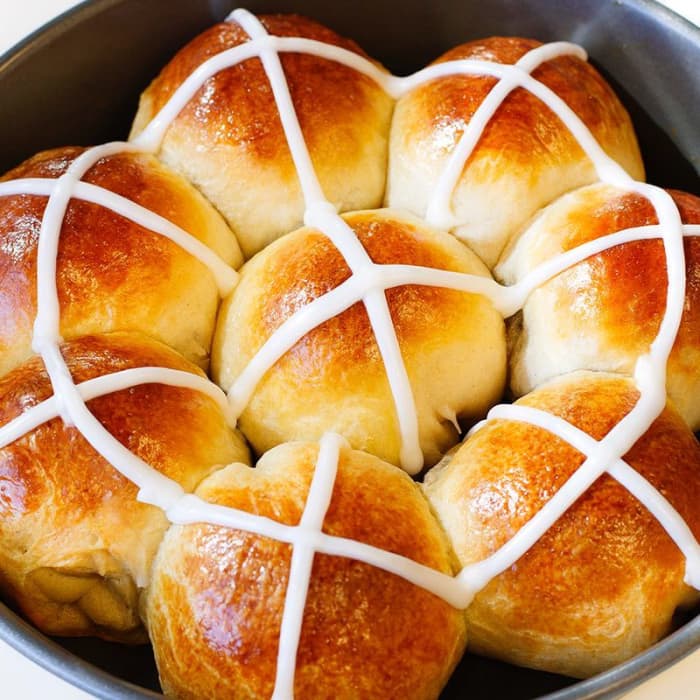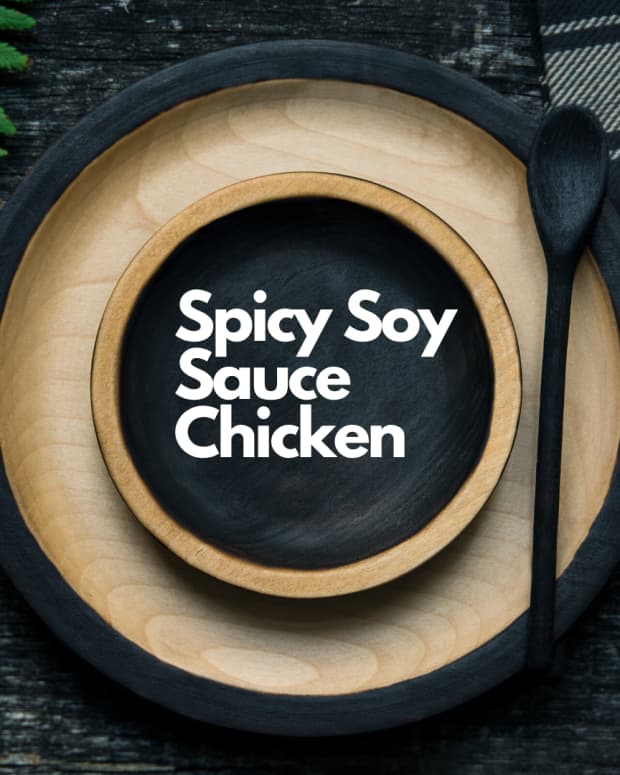Hot Cross Buns: Fun Facts and a Recipe
Cheryl is a licensed, ordained minister and has a BA in Psychology and Church ministry.
A Children's Rhyme
I remember reading the nursery rhyme hot cross buns when I was a child. My friends and I would also recite the lyrics while placing our hands in the patty cake position.
Hot cross buns
Hot cross buns
One a penny
Two a penny
Hot cross bunsGive them to your daughters
Give them to your sons
One a penny
Two a penny
Hot cross bunsHot cross buns
Hot cross buns
One a penny
Two a penny
Hot cross bunsGive them to your daughters
Give them to your sons
One a penny
Two a penny
Hot cross bunsThese are sure hot
In my 62 years on this earth, I never heard anyone explain the origin of these words. My family celebrated Easter each spring, but we never ate hot cross buns and I never associated them with the resurrection of Christ until today. This bread was the answer to a Jeopardy question, and host Alex Trebek said they were eaten during Easter. I asked my husband, and he said he had never heard anything about this food beyond the children's nursey rhyme—so I decided to do some research.
Blame It on the Pagans and the Queen
The tradition of baking bread marked with a cross originated in paganism and was later copied by the Christians. The Saxons would bake cross buns when spring arrived in honor of the goddess Eostre, whom many believe is where the name Easter came from. The pagan roots of the name is why today many believers in Christ prefer to say Resurrection Sunday instead of Easter.
The cross for the nonbelievers represented the rebirth of the world after the winter season as well as the four, yearly seasons and the four quarters of the moon. When Christians saw the cross on the bun they were reminded of the Resurrection of Christ and decided to use the symbol in the same way they replaced the pagan festivals of the spring and winter solstice with Christmas and Easter.
It was not until Tudor times that hot cross buns were permanently linked to Christian celebrations. The Tudor period occurred between 1485 and 1603 in Wales and England and includes the Elizabethan period, which began during the reign of Queen Elizabeth I and lasted until her reign ended in 1603. It was during this period that the London Clerk of Markets issued a decree forbidding the sale of spiced buns (hot cross buns) except during Christmas, on Good Friday and when burying the dead.
Symbols and Traditions
Hot cross buns are a spiced sweet bun that is usually made with fruit. They are marked on the top with a cross that is made with flour and water prior to baking. This can cause the cross to be hard, so using icing after the buns are done works better.
In the United Kingdom, New Zealand, Ireland, Australia, South Africa, India, and some parts of the United States and Canada, these buns are eaten on Good Friday, which is the day that many believe Christ was crucified.
For some this bread marks the end of Lent, and different parts of the hot cross bun have a specific meaning. The cross represents the crucifixion of Christ, and the spices baked inside signify the spices used to embalm His body after He was placed in the tomb.
Hot cross buns can be found year-round in some locations and may go on sale in New Zealand, Australia, and the United Kingdom after Christmas or on New Year's Day. I cannot find anything to verify this, but I vaguely recall seeing a television show as a child where a street vendor was calling, "Get your hot cross buns!" over and over.
Recipe
Here is one easy recipe for hot cross buns. You can find others by searching online.
Ingredients
- 6 to 7 cups all-purpose flour
- 2 (1/4-ounce) packages active dry yeast
- 2 cups warm whole milk (110° to 115°)
- 2 large eggs, room temperature
- 1 1/2 teaspoons salt
- 1 teaspoon ground cinnamon
- 1/4 teaspoon ground allspice
- 1/2 cup dried currants
- 1/2 cup raisins
- 1/3 cup butter, softened 1/4 cup sugar
- 1 large egg yolk
- 2 tablespoons water
For the icing:
- 1 1/2 cups confectioners' sugar
- 4 to 6 teaspoons whole milk
Instructions
- In a small bowl, dissolve the yeast in warm milk. In a large bowl, combine the sugar, eggs, butter, spices, salt, yeast mixture, and 3 cups flour. Beat on medium speed until smooth. Stir in the raisins, currants, and enough remaining flour to form a soft, sticky dough.
- Turn the dough out onto a floured surface and knead until it is smooth and elastic (about 6-8 minutes). Place the mixture in a greased bowl, turning once to grease the top. Cover and allow it to rise in a warm place until doubled in size (about 1 hour).
- Punch down the dough then turn it out onto a lightly floured surface. Divide and shape into 30 balls. Place the balls 2 inches apart on a greased baking sheet. Cover with kitchen towels and allow it to rise in a warm place until doubled (30-45 minutes). Preheat oven to 375°F.
- Using a sharp knife, cut a cross in the top of each bun. In a small bowl, whisk egg yolk and water; brush over tops. Bake for 15-20 minutes or until golden brown. Remove from pans to wire racks to cool slightly.
- For icing, use a small bowl to mix confectioners' sugar and enough milk to reach desired consistency. Pipe a cross on top of each bun and serve while warm.
© 2020 Cheryl E Preston
Comments
Cheryl E Preston (author) from Roanoke on August 24, 2020:
Thank you for reading.
Dora Weithers from The Caribbean on August 24, 2020:
Thanks for sharing your recipe. The legend of hot cross buns is familiar to Caribbeans in my generation. Still, I loved reading your article. Your photos look so tempting.
Cheryl E Preston (author) from Roanoke on August 22, 2020:
Thanks for reading and I’m glad you enjoy them.
Liza from USA on August 22, 2020:
I love hot cross buns. I made them several times, especially in the Fall time. I love the smell of the spices combined in the dough, warm, and they are delicious with coffee or tea. Thank you for sharing the history behind the hot cross buns, Cheryl. Thanks for the recipe too!
Cheryl E Preston (author) from Roanoke on August 20, 2020:
Thank you so much for reading
Peggy Woods from Houston, Texas on August 20, 2020:
Your recipe sounds delicious. I do not remember ever eating a hot cross bun, but enjoyed learning the history behind the meaning of them.
Sp Greaney from Ireland on August 20, 2020:
I figured it was the British who turned us onto them just like they did with the crumpets. I didn't know the whole background on them though. That's very interesting.
You cannot go into a shop here before or after Easter without seeing them in the bread aisle.
Cheryl E Preston (author) from Roanoke on August 20, 2020:
Thank you Pamela for reading.
Pamela Oglesby from Sunny Florida on August 20, 2020:
I had hot cross buns when I was young but I didn't know the significance. The history of the buns is very interesting, and the full meaning is fascinating also. Thanks for the recipe and this interesting article, Cheryl.
Cheryl E Preston (author) from Roanoke on August 20, 2020:
Thank you for sharing that. I had absolutely no idea of the origin in all my years.
Ann Carr from SW England on August 20, 2020:
Being English, I was brought up with these too and we still have them, traditionally for Good Friday every year, signifying Christ on the cross.
They are delicious cinnamon currant/sultana buns.
Trouble is, the shops seem to sell them almost all year round now, which takes away their 'special' status and kind of spoils the whole reason for having them.
One extra line we had in the rhyme was 'If you have no daughters, give them to your sons', a slight variation.
The old customs are interesting. There are many pagan rituals incorporated into the Christian festivals or modified to suit, in order to appease the pagans and accept some of their culture.
The smell of them is almost as delicious as the taste!
Good idea to include the recipe!
Ann
Danny from India on August 20, 2020:
Cheryl this makes me remind of our fun time during Xmas. We source different varieties of cross buns and its such a treat. thanks for reminding.

















